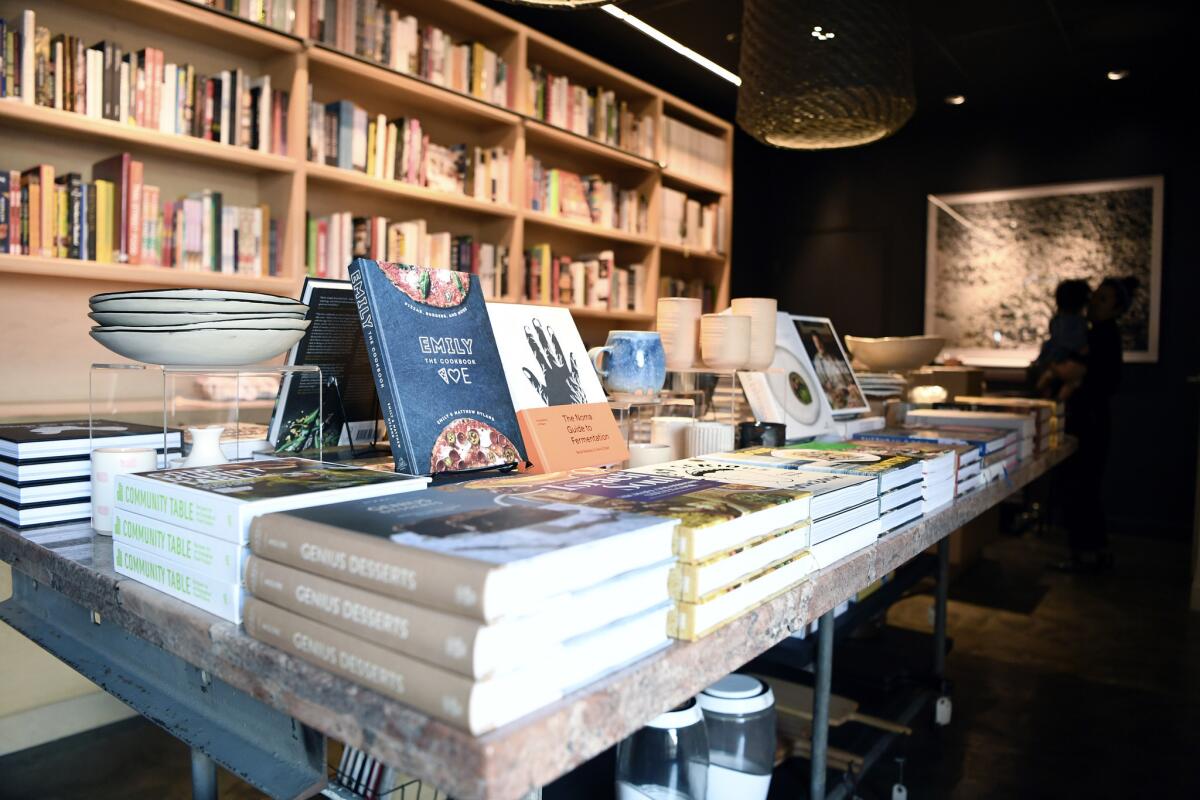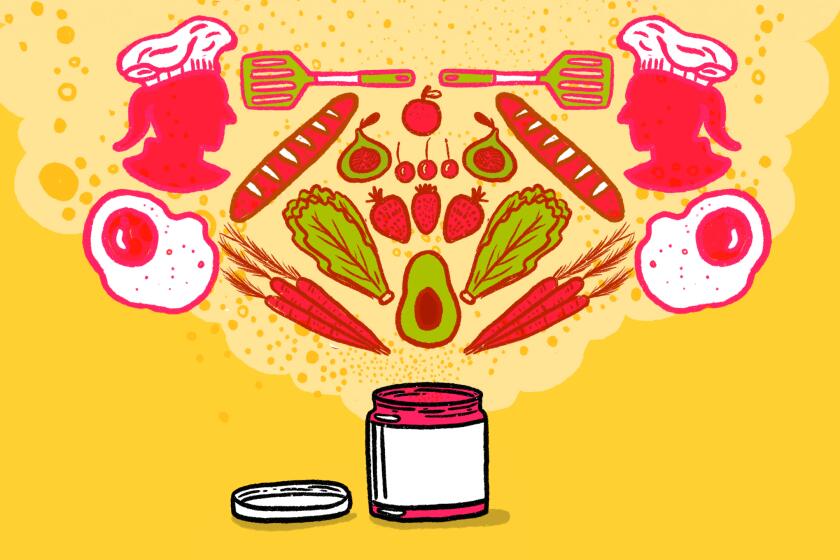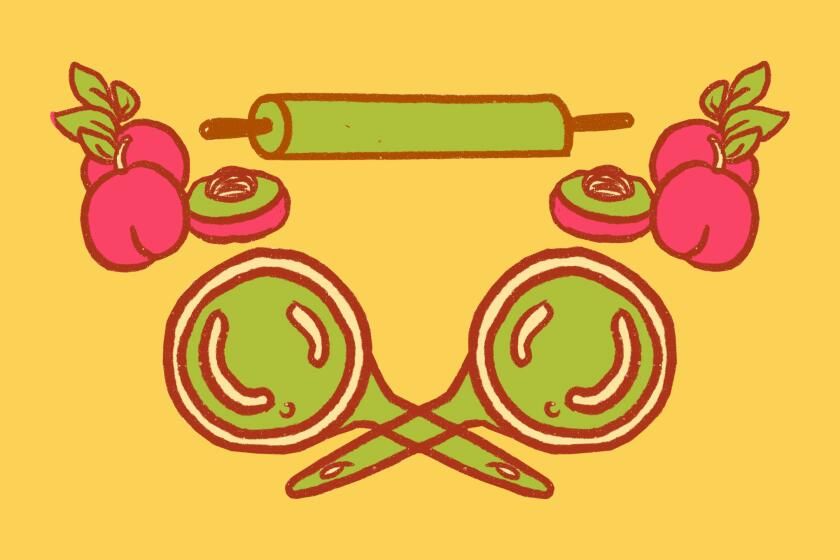Column: What we talk about when we talk about recipe ownership

- Share via
It’s a long-held tradition that dishes in a restaurant be attributed to the executive chef or to the establishment itself. And that tradition extends to recipes and cookbooks released from those restaurants.
Chad Colby, former chef of Chi Spacca, put it this way: “At some point, they’re going to come out with a Chi Spacca cookbook and it would be totally fair for them to exclude me from the book. Anything I did there, I did for that restaurant.”
Issues of credit and attribution in restaurants are sticky — there is no accepted standard. Is it practical to list the names of everyone who contributed an idea or technique to the menu? Is it sufficient to tag them in Instagram posts? Those issues are present in cookbook publishing as well.
Who owns a recipe, anyway?
The website of the U.S. Copyright Office notes that if “a recipe or formula is accompanied by substantial literary expression in the form of an explanation or directions, or when there is a collection of recipes as in a cookbook, there may be a basis for copyright protection.” But recipes themselves, “a mere listing of ingredients,” are not on the table for copyright protection.
“You take an eighth of a teaspoon of salt off of a recipe and slap ‘adapted by’ on it and suddenly it’s your recipe,” said Jamie Feldmar, a writer (and Times contributor) and co-author of five cookbooks. Food and recipes, she added later, are subjective and ephemeral. Whether it’s right or wrong, “It is how things are. You’ve never been able to copyright a recipe.”
In traditional kitchens, it’s long been accepted that whatever cooks create there belongs to the restaurant and its chef. Some are challenging that.
Financial and attribution details around cookbooks can be inconsistent and somewhat opaque, as they’re usually left up to the chef with the book contract. More often than not, the chef gets a lump of money in advance and apportions it the way he or she sees fit — for the photographer, the designer, the recipe testers and any contributors.
“That becomes essentially their budget for making their book,” said one editor at a large publishing house, who asked not to be named because he was not authorized to speak on behalf of his company. “Call it $150K. You might pay your cowriter $50, you might pay your photographer $50, you’ll pay for a recipe tester or ingredients for recipes, and the rest is yours,” he said. “It is up to you.”
He added that it’s commonplace for the titular head of a restaurant to receive credit for everything in a cookbook, regardless of whether that reflects reality or not. “I can see why it’s frustrating for the cook to see the chef being celebrated for your brainchild,” the editor said. “I’m not saying it’s right that that is how the situation works, but that’s how it’s been up to this point.”
When chefs receive lucrative book deals, should contributing staff, past and present, also enjoy the spoils? “We should have that conversation, but I don’t think anyone thought that that was how things worked,” the editor said.
Some would like to see more transparency in the process.
Javier Ramos was Sqirl’s chef de cuisine in 2016 when owner Jessica Koslow’s cookbook, “Everything I Want to Eat,” was released. Ramos said he made contributions to the book but that his salary “wasn’t reflective of writing a cookbook.” (Ramos said he joined Sqirl at a $55,000 annual salary to lead its kitchen.)
Existing cracks in the restaurant system, further exacerbated by COVID-19, have left chefs looking for solutions. One restaurant group in South Carolina, City Grit, is experimenting with a nontraditional model.
Other members of the Sqirl team, pastry chef Meadow Ramsey and former chef de cuisine Ria Dolly Barbosa, said they contributed to the cookbook as well. Ramos, Ramsey and others were thanked in its pages.
But Barbosa was not mentioned, and she says at least one of her recipes was included in the book: a variation of a crab dish inspired by her childhood.
“That dish specifically is so personal to me,” she said. “When I was little, my parents would take us to San Pedro or Redondo Beach in the summer. We would eat crab with rice and a ton of lemon juice.”
It was particularly painful, she said, to not receive thanks in the book while others did. “Not a peep, not a mention,” she said.
A spokesperson for Koslow said the recipes Barbosa developed were done “at Sqirl, for Sqirl” but that they “evolved before their inclusion in the cookbook ‘Everything I Want to Eat’ and have evolved further since.”
“There is a common misconception that a cookbook is created solely by the person whose name is on the cover,” Maria Zizka, who was hired to cowrite “Everything I Want to Eat,” said in an emailed statement. “That has never been true. Cookbooks are brought to life by large teams of people, and the person whose name is on the cover has a responsibility to be transparent.”
“I lean pretty heavily toward widely acknowledging the people who should be credited,” said Naomi Pomeroy, chef-owner of Beast in Portland, Ore., and the author of “Taste & Technique: Recipes to Elevate Your Home Cooking.” In the “Desserts & Pastry” section of the book, Pomeroy said she felt a particular need to credit her pastry chef, Ellen Laing. “I not only acknowledged her in the section but I also paid her for her work,” Pomeroy said. “That’s because she was predominantly responsible for developing and testing those recipes.”
Pastry chef Roxana Jullapat, co-owner of Friends & Family, also emphasized a need for transparency when publishing a book that belongs to a particular restaurant or chef. “When it comes to a cookbook, if any of your staff had a hand in it, it wouldn’t feel good if I didn’t share,” she said.
“There is a blessing called the acknowledgments section where you can thank everybody ad nauseam.”
More to Read
Eat your way across L.A.
Get our weekly Tasting Notes newsletter for reviews, news and more.
You may occasionally receive promotional content from the Los Angeles Times.













